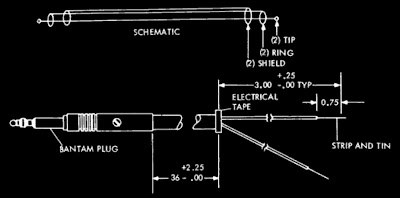 It is one of the most commonly used audio connectors in existence today but it's official name is almost unknown to the layperson. It's called an audio-jack, phone plug, Bantam Plugs, jack-plug, stereo-plug, mini-jack, mini-stereo, quarter-inch plug, or headphone-jack. None of those are correct hyphenated or otherwise. It's a A TRS connector. They are rare today in radio, but I used to see them in patch bays all the time.
It is one of the most commonly used audio connectors in existence today but it's official name is almost unknown to the layperson. It's called an audio-jack, phone plug, Bantam Plugs, jack-plug, stereo-plug, mini-jack, mini-stereo, quarter-inch plug, or headphone-jack. None of those are correct hyphenated or otherwise. It's a A TRS connector. They are rare today in radio, but I used to see them in patch bays all the time.The TRS stand for Tip, Ring and Sleeve. Some versions may be TRRS connectors or TR connectors based on the number of rings. The original 1/4″ (6.35 mm) TR version dates all the way back to about 1870 making it the oldest audio connector still in use today. It began as a connector for telephone patch cord for manual telephone relay. It was first patented in 1879 by C.E. Scribner of the Western Electric Manufacturing Company. Buit was certainly in use well before that. The diagram above dates to 1883. These early connectors were called a "jacknife" because of a perfunctory resemblance to the cutting tool. That is also the etymology of the term "jack."
 The Tip/Ring/Sleeve segments are comparable to standard 3 Prong electrical connectors. In a "Balanced" system that equates to Positive/Negative/Ground. In an Audio System that equates to Left Channel, Right channel, Ground. The Sleeve is always ground, even in unbalanced systems. The tip is always the signal. The Ring can be return path, ground or nothing at all.
The Tip/Ring/Sleeve segments are comparable to standard 3 Prong electrical connectors. In a "Balanced" system that equates to Positive/Negative/Ground. In an Audio System that equates to Left Channel, Right channel, Ground. The Sleeve is always ground, even in unbalanced systems. The tip is always the signal. The Ring can be return path, ground or nothing at all.But this results in some interesting incompatibilities. If a TRS plug is connected to a TRRS socket, the result is that the ring (right channel) of the socket is grounded. In an audio system this would be the loss of the Right Stereo channel. But if these are amplified channels, grounding out one channel can be hazardous.
 Alternately if a TRRS plug is connected to a TRS socket, the result is to leave the ring of the plug unconnected creating an open circuit. Solid state hardware handles this well, creating a mono output, but vintage tube driven hardware does not.
Alternately if a TRRS plug is connected to a TRS socket, the result is to leave the ring of the plug unconnected creating an open circuit. Solid state hardware handles this well, creating a mono output, but vintage tube driven hardware does not.




No comments:
Post a Comment